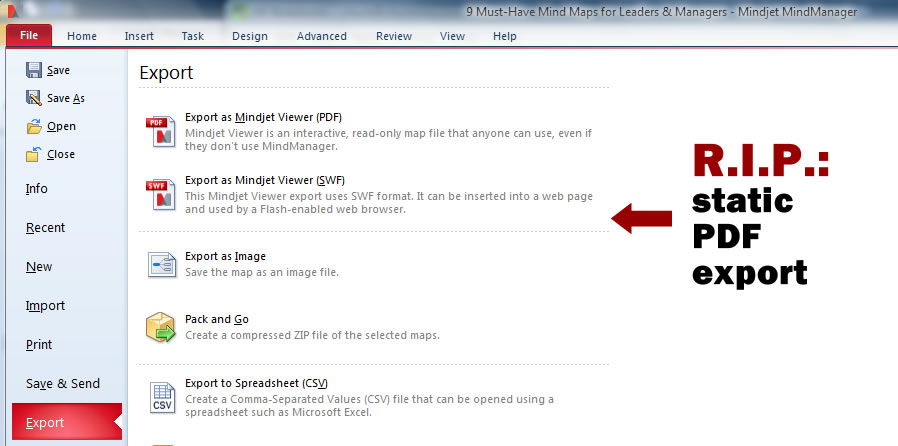Recently, I was trying to export a mind map of a plan for my new employer to a static PDF in MindManager 15. Sounds simple, right? Not in the latest version of this popular mind mapping program, which no longer supports this capability.
The latest iteration of MindManager only exports to two varieties of interactive PDF, which use capabilities of Flash that are embedded in new versions of Acrobat Reader to enable you to expand and contract map branches and to click links embedded in your mind map. To view these interactive maps, you need to have a fairly recent version of Adobe Acrobat Reader.
In previous versions of MindManager, static PDF export was always an option. Here’s what happened, and what I learned about Mindjet’s decision to do away with this export type. More importantly, I also share several work-arounds you can use to create static PDFs from MindManager 15.
How I discovered this change
Last week, I started a new job as director of online training for the Content Marketing Institute. One of my first tasks is to produce an implementation plan for for marketing and providing sales support for this new service, as well as a process for onboarding new corporate clients.
With such a multifaceted project, I turned to MindManager 15 to map out my thinking. But I was unpleasantly surprised when I went to export it and discovered that version 15 no longer supports static PDF exports. I wanted to use this legacy format just in case my coworkers were using older versions of Acrobat Reader.
But it was clear that I didn’t have a choice after all the work that I put into this plan. So I sent it to my new boss and another colleague. Both of them encountered problems opening this file; my boss had to upgrade Acrobat Reader twice before it would display properly.
Work-arounds for this export issue
So I reached out to Michael Deutch, vice president of products at Mindjet, to learn more about this change and the reasons behind it. He provided a reasonable explanation why this functionality disappeared in version 15, and shared several work-arounds you can use:
“The vendor we previously used for the PDF export significantly changed their licensing model. We found that there are a variety of free and low-cost PDF drivers that individuals can install that will restore this capability, not just for MindManager but for all of their applications.
“Another workaround is that the Image Export produces an identical static visual output as the PDF. You could export an image of the map and share it just as easily, in fact, you can arguably do more with it than a PDF (e.g. include it in documents, emails, presentations, annotate it using Paint or other applications, etc.).”
You can also export your mind map as an image (don’t use JPG or GIF formats because they don’t scale well – PNG works best) and then insert the image into a Microsoft Word document. Then output the document as a PDF.
Why am I sharing this information with you?
Because I realize that many large corporations often lag behind the current versions of software, which makes it likely that someone to whom you’re planning to send a mind map may not be able to view interactive PDFs. Keep this in mind as you create and share your mind maps in enterprise environments.


Leave a Reply